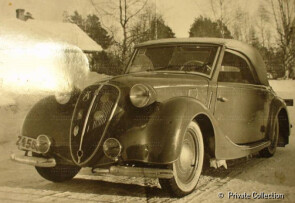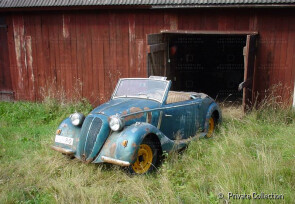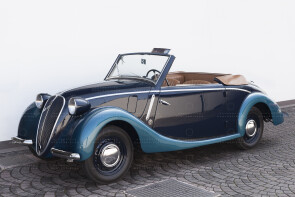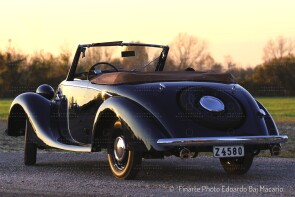
1938 NSU-Fiat 508 C Cabriolet
ON/OFF
Why am I an Automotive Masterpiece?
L. Limited edition cars
28th built. 29
The story begins with the "Balilla," the iconic car that FIAT launched in the 1930s, marking the beginning of Italy’s mass motorization. The name itself was steeped in the propaganda of the era, yet the car garnered widespread affection and became a beloved symbol of mobility. Almost every Italian family has a memory tied to this car. The Balilla laid the foundation for an entire lineage of FIAT cars, culminating in the 1100 series, with the Fiat 508 C serving as the pivotal link. Introduced in 1937, the Fiat 508 C replaced the Balilla’s original 1-litre engine with a more powerful 1,089 cc 4-cylinder unit, bringing new performance standards to its class. Designed by notable automotive engineers and designers of the time—Tranquillo Zerbi, Antonio Fessia, Bartolomeo Nebbia, and Dante Giacosa—the Balilla offered a blend of elegance, performance, and affordability. This team of visionaries created a vehicle that could compete with higher-end cars while remaining accessible to the masses. Last evolution of this lucky model and, so, initially marketed as the “Nuova Balilla 1100” in advertising materials, the 508 C quickly became known simply as the "1100," a name that resonated with motorists. Between 1937 and 1939, Fiat produced approximately 57,000 units across various body styles, including Cabriolet, Berlina, and Berlina tetto apribile (open top). Priced at 19,500 Lira, it was a car that took a decisive step ahead of the Balilla: it combined style with practicality, offering rounded, aerodynamic lines inspired by the FIAT 1500. Under the hood was the Fiat 108C engine—a 1,089 cc inline 4-cylinder overhead valve (OHV) engine paired with a 4-speed gearbox. With a power output of 32 hp at 4,000 rpm, the car could reach a top speed of 95 km/h, a remarkable feat for its price segment. The independent front suspension with transverse arms, coil springs, and hydraulic shock absorbers was a rarity in low-cost vehicles of the time, offering a smooth and comfortable ride. The Fiat 508 C was praised for its comfort, agility, and performance, earning it the nickname "the only people’s car that was also a driver’s car." Its sporting pedigree was highlighted by its participation in races, including the prestigious Mille Miglia. The car’s success on the track further cemented its reputation as a versatile and capable machine. In 1938, Fiat introduced the 508 L (Lunga), a long-wheelbase version capable of seating six passengers. This model became particularly popular as a taxi, thanks to its spacious interior and practicality. In 1939, the 508 C underwent a significant redesign of its front end, resulting in the so-called Fiat 1100 “Musone” (“big nose”), named for its prominent, vertical grille. This facelift marked the transition to a more imposing aesthetic, aligning with the stylistic trends of the late 1930s. The 508 C also left its mark culturally, with notable owners such as soccer player Gigi Meroni.
NSU (Neckarsulmer Strickmaschinenfabrik) was a German manufacturer of textile machines founded in 1873 by Christian Schmidt and Heinrich Stoll, two young mechanics. Despite early collaborations with Gottlieb Daimler and Wilhelm Maybach we need to wait for the 1900s to have an NSU car. At the end of the First World War, the situation in Germany was chaotic. The supply of raw materials was also tricky. The NSU was among car manufacturers in severe trouble, and this situation dragged on for years to come. The solution came from Italy, and more precisely from Turin. FIAT was, at that time, the largest European manufacturer and had more than enough resources to take over the NSU in exchange for its more incisive penetration into the German market. The newborn NSU-Fiat was a car manufacturer under Fiat license in Germany. Only one vehicle from the NSU production remained, the NSU 7/34 PS Wagen, built until 1931. Fiat immediately began construction under its license of Fiat models, like the 500 "Topolino" and the Fiat 508 Balilla and sold them under the name NSU-Fiat. During that period, the same cars were made in France under the name Simca-FIAT. The production of the NSU-Fiat ended in 1941, in the middle of WWII. Gläser-Karosserie GmbH was a German coachbuilder, based in Dresden and known as a producer of custom-built cabriolet car bodies. The company was founded in 1864 and remained operative until 1952. Like NSU, also Gläser-Karosserie had seen several financially challenging years. During the 1930s Gläser-Karosserie produced cabriolet and other custom-built bodies for Auto Union brands, notably luxury bodies for Horch cars, but it was also producing bodies to use with chassis from other important German car makers. From 1935, the factory was also supporting the German military rearmament with unique bodies for "commando/staff cars". The 508 C was built by the NSU-Fiat with the permission of Fiat itself and was mechanically identical to the Italian car. Some frames were entrusted, as was the custom of the time, to coachbuilders such as the Gläser-Karosserie, specialised in luxury convertibles, as previously told.
Chassis no. 216239 is the 28th of only 29 cars built by the famous Gläser-Karosserie under the NSU license. While starting from the chassis and mechanical parts of the popular Fiat 508 C, the Gläser specialisation in luxury cars building is visible in every detail of the car. This type of car is listed and shown in the Gläser production brochure of the time and identified as a “SportWagen-cabriolet”. The story of the example is well known; while most of these cars were meant for the German market, the chassis no. 216239 was sold in Sweden, and still had (until 2019) Swedish documents and original Swedish plates. The car had in Sweden a sporty life: anong the owners, it is believed to have belonged to Anton "Skeks" Hansson, a well-known aviator, writer and manufacturer of ice-suited vehicles. He was also a racing car driver and used chassis no. 216239 in rallies on the ice, documented by photos of the era. The chassis no. 216239 was restored to perfection. The author of the restoration replaced the Simca engine, found on the car, with a Fiat 1100 engine consistent with the vehicle. The dark blue colour with brown leather interiors and canvas hood, the chrome mouldings and details, enhance the meticulous construction of this rare Gläser version, that recalls the luxurious bodyworks of the great German cars very much, even if on a reduced scale.




